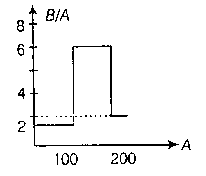Subtopic: Current & Current Density |
Please attempt this question first.
Hints
A ray of light travelling in water is incident on its surface open to air. The angle of incidence is θ, which is less than the critical angle. Then there will be,
Subtopic: Total Internal Reflection |
Please attempt this question first.
Hints
Assume that the nuclear binding energy per nuclear (B/A) versus mass number (A) is as shown in the figure. Use this plot to choose the correct choice(s) given below:
1. Fusion of two nuclei with mass number lying in the range of 51<A<100 will release energy
2. Fusion of a nucleus lying in the mass range of 200<A<260 will release energy when broken into two equal fragments
3. Both A and B
4. None of these
Subtopic: Nuclear Binding Energy |
From NCERT
Please attempt this question first.
Hints
Please attempt this question first.
Subtopic: Lens Makers' Formula |
51%
Please attempt this question first.
Hints
Please attempt this question first.
A parallel plate capacitor of capacitance C is connected to a battery and is charged to a potential difference V.
Another capacitor of capacitance 2C is connected to another battery and is charged to potential difference 2V. The charging batteries are now disconnected and the capacitors are connected in parallel to each other in such a way that the positive terminal of one is connected to the negative terminal of one is connected to the negative terminal of the other. The final energy of the configuration is
Another capacitor of capacitance 2C is connected to another battery and is charged to potential difference 2V. The charging batteries are now disconnected and the capacitors are connected in parallel to each other in such a way that the positive terminal of one is connected to the negative terminal of one is connected to the negative terminal of the other. The final energy of the configuration is
1. Zero
Subtopic: Energy stored in Capacitor |
Please attempt this question first.
Hints
The n rows each containing m cells in series are joined in parallel. Maximum current is taken from this combination across an external resistance of 3 Ω. If the total number of cells used is 24 and internal resistance of each cell is 0.5 Ω, then
1. m = 8, n = 3
Subtopic: Grouping of Cells |
Please attempt this question first.
Hints
If the intensities of the two interfering beams in Young’s double-slit experiment are  and
and  then the contrast between the maximum and minimum intensities are good when
then the contrast between the maximum and minimum intensities are good when
1.  is large
is large
Subtopic: Young's Double Slit Experiment |
Please attempt this question first.
Hints
A simple telescope, consisting of an objective of focal length 60 cm and a single eye lens of focal length 5 cm is focused on a distant object in such a way that parallel rays emerge from the eye lens. If the object makes an angle of 2 º at the objective, then the angular width of the image is
1. 10 º
Please attempt this question first.
Hints
A semiconductor has an electron concentration of per
and a hole concentration of
per
. The electron mobility is 25000
and the hole mobility is 100
. Then,
1. the semiconductor is n-type
Subtopic: Types of Semiconductors |
54%
Please attempt this question first.
Hints
An ammeter and a voltmeter are joined in series to a cell. Their readings are A and V respectively. A resistance is now joined in parallel with the voltmeter. Then,
Subtopic: Grouping of Cells |
Please attempt this question first.
Hints



